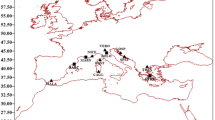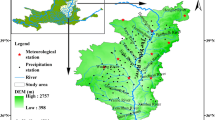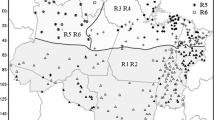Abstract
In this study, generalized extreme value distribution (GEV) and generalized Pareto distribution (GPD) were fitted to the maximum and minimum temperature, maximum wind speed, and maximum precipitation series of Zanjan. Maximum (minimum) daily and absolute annual observations of Zanjan station from 1961 to 2011 were used. The parameters of the distributions were estimated using the maximum likelihood estimation method. Quantiles corresponding to 2, 5, 10, 25, 50, and 100 years return periods were calculated. It was found that both candidate distributions fitted to extreme events series, were statistically reasonable. Most of the observations from 1961 to 2011 were found to fall within 1–10 years return period. Low extremal index (θ) values were found for excess maximum and minimum temperatures over a high threshold, indicating the occurrence of consecutively high peaks. For the purpose of filtering the dependent observations to obtain a set of approximately independent threshold excesses, a declustering method was performed, which separated the excesses into clusters, then the de-clustered peaks were fitted to the GPD. In both models, values of the shape parameters of extreme precipitation and extreme wind speed were close to zero. The shape parameter was less negative in the GPD than the GEV. This leads to significantly lower return period estimates for high extremes with the GPD model.



















Similar content being viewed by others
References
Abaurrea J, Asín J, Cebrián AC, Centelles A (2007) Modeling and forecasting extreme hot events in the central Ebro Valley, a continental-Mediterranean area. Glob Planet Change 57:43–58
Asakereh H (2012) Frequency distribution change of extreme precipitation in Zanjan City. Geogr Environ Plan J, 23rd Year, 45(1):13-17
Beirlant J, Goegebeur Y, Segers J, Teugels J (2004) Statistics of extremes: theory and applications. Wiley series in probability and statistics. Chichester
Caers J, Maes MA (1998) Identifying tail bounds and end points of random variables. Struct Saf 20:1–23
Ceppi P, Della-Marta PM, Appenzeller C (2008) Extreme value analysis of wind speed observations over Switzerland, Arbeitsberichte der MeteoSchweiz, No: 219. Bundesamt für Meteorologie und Klimatologie, MeteoSchweiz
Coles SG (2001) An introduction to statistical extreme values. Springer, London
de Oliveira MMF, Ebecken NFF, de Oliveira JLF, Gilleland E (2010) Generalized extreme wind speed distributions in South America over the Atlantic Ocean region. Theor Appl Climatol 104:377–385. doi:10.1007/s00704-010-0350-3
Dougherty AM, Corotis RB (1998) Extreme wind estimation: theoretical considerations. In: Proceedings of the 7th international conference on structural safety and reliability
Gilleland E, Katz RW (2005a) Extremes toolkit (extRemes): weather and climate applications of extreme value statistics. http://www.isse.ucar.edu/extremevalues/tutorial.pdf
Gilleland E, Katz RW (2005b) Analysing seasonal to interannual extreme weather and climate variability with the extremes toolkit. National Center for Atmospheric Research (NCAR), Boulder
Gilleland E, Katz RW (2006) Analyzing seasonal to interannual extreme weather and climate variability with the extremes toolkit. Research Applications Laboratory National Center for Atmospheric Research (NCAR), Boulder
Hashmi MZ, Shamseldin AY, Melville BW (2011) Comparison of SDSM and LARS-WG for simulation and downscaling of extreme precipitation events in a watershed. Stoch Environ Res Risk Assess 25(4):475–484
Holmes JD, Moriarty WW (1999) Application of the generalized Pareto distribution to extreme value analysis in wind engineering. J Wind Eng Ind Aerodyn 83:1–10
Hosking JRM, Wallis JR, Wood EF (1985) Estimation of the general extreme value distribution by the method of probability weighted moments. Technometrics 27(3):251–261
Katz RW, Parlange MB, Naveau P (2002) Statistics of extremes in hydrology. Adv Water Resour 25:1287–1304
Kharin VV, Zwiers FW (2000) Changes in the extremes in an ensemble of transient climate simulations with a coupled atmosphere–ocean GCM. J Clim 13:3760–3788
Kharin VV, Zwiers FW (2005) Estimating extremes in transient climate change simulations. J Clim 18:1156–1173
Kysely J, Picek J, Beranova R (2010) Estimating extremes in climate change simulations using the peaks-over-threshold method with a non-stationary threshold, Global and Planetary Change 72:55–68
Laurent C, Parey S (2007) Estimation of 100-year-return-period temperatures in France in a non-stationary climate: results from observations and IPCC scenarios. Glob Planet Change 57(1–2):177–188
Lechner JA, Leigh SD, Simiu E (1992) Recent approaches to extreme value estimation with application to wind speeds. Part I: the Pickands Method. J Wind Eng Ind Aerodyn 41–44:509–519
Lin XG (2003) Statistical modeling of severe wind gust. In: International congress on modelling and simulation, Townsville, 14–17 July, vol 2, pp. 620–625
Mazas F, Hamm L (2011) A multi-distribution approach to POT methods for determining extreme wave heights. Coast Eng 58:385–394
Naveau P, Nogaj M, Ammann C, Yiou P, Cooley D, Jomelli V (2005) Statistical methods for the analysis of climate extremes. C R Geosci 337:1013–1022
Nemeth C (2011) Extreme value theory project. Statistics and Operational Research Doctoral Training Centre (STOR-i DTC), Lancaster University, Lancaster
Parey S, Malek F, Laurent C, Dacunha-Castelle D (2007) Trend and climate evaluation: statistical approach for very high temperatures in France. Clim Change 81:331–352
Payer T, Kuchenhoff H (2004) Modelling extreme wind speeds at a German weather station as basic input for a subsequent risk analysis for high-speed trains. J Wind Eng Ind Aerodyn 92:241–261
Rao AR, Hamed KH (2000) Flood frequency analysis. CRC Press, Boca Raton
Reiss R, Thomas M (2001) Statistical analysis of extreme values from insurance, finance, hydrology and other fields. Birkhauser, New York
Renald B, Lang M, Bois P (2006) Statistical analysis of extreme events in a non-stationary context via a Bayesian framework: case study with peak-over-threshold data. Stoch Environ Res Risk Assess 21(2):97–112
Sanabria LA, Cechet RP (2007) A statistical model of severe winds. Geoscience Australia, Record 2007/12. ISSN 1448-2177, ISBN 978 1 921236 43 3
Sanabria LA, Cechet RP (2010) Extreme value analysis for gridded data. In: Swayne DA, Yang W, Voinov AA, Rizzoli A, Filatova T (eds) International Environmental Modelling and Software Society (iEMSs) 2010 international congress on environmental modelling and software modelling for environment’s sake, fifth biennial meeting, Ottawa, Canada. http://www.iemss.org/iemss2010/papers/S28/S.28.02.Extreme%20value%20analysis%20for%20gridded%20data%20-%20L.A.%20SANABRIA.pdf
Smith RL (2003) Statistics of extremes, with applications in environment, insurance and finance. In: Finkenstadt B, Rootzen H (eds) Chapter 1 of extreme values in finance, telecommunications and the environment, Chapman, Hall/CRC Press, London, pp 1–78.http://www.stat.unc.edu/postscript/rs/semstatrls.pdf
Taghavi F, Mohammadi H (2007) Study the return period of extreme climate events for reduction of environmental impacts. J Environ Stud 33(43):11–20
Unkasevic M, Tosic I (2009) Changes in extreme daily winter and summer temperatures in Belgrade. Theor Appl Climatol 95:27–38. doi:10.1007/s00704-007-0364-7
Van Den Brink HW, Konnen GP, Opsteegh JD (2004) Statistics of extreme synoptic-scale wind speeds in ensemble simulations of current and future climate. J Clim 17:4564–4574
Author information
Authors and Affiliations
Corresponding author
Rights and permissions
About this article
Cite this article
Jahanbaksh Asl, S., Khorshiddoust, A.M., Dinpashoh, Y. et al. Frequency analysis of climate extreme events in Zanjan, Iran. Stoch Environ Res Risk Assess 27, 1637–1650 (2013). https://doi.org/10.1007/s00477-013-0701-6
Published:
Issue Date:
DOI: https://doi.org/10.1007/s00477-013-0701-6




